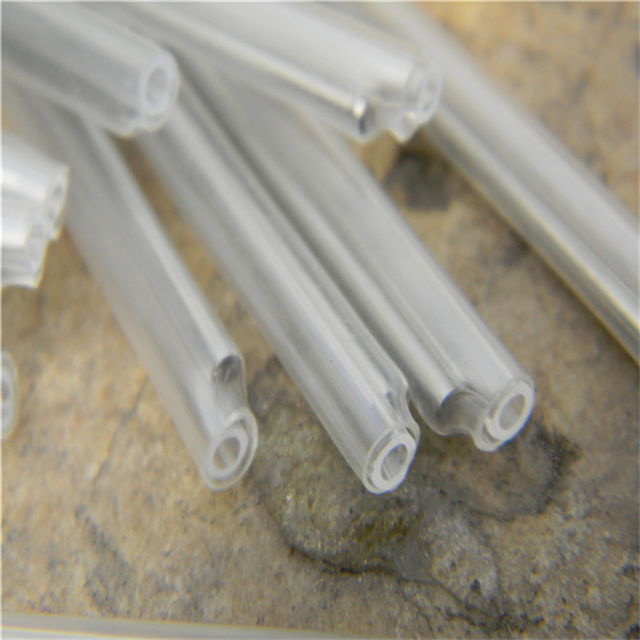- Time:2019/10/12 posted:Kehong Enterprises Co.,Ltd.
Fiber heat-shrinkable tube: It consists of a transparent heat-shrinkable tube, a hot-melt tube and a stainless steel needle (or ceramic rod/quartz rod). The transparent outer layer facilitates the detection of the correct connection of the fiber joints, enables the fiber to be assembled simply and safely, maintains the optical transmission characteristics of the fiber after shrinkage, and provides strength and protection to the fiber joint. Easy to operate and reliable, it can avoid damage to the fiber during installation.
Optical fiber is an important part of an optical communication system, and it provides a channel for optical signal transmission. Optical fibers are typically composed of a core, a cladding, and a coating. Both the core and the cladding are high-purity silica. Because the doping ratio of the dopant is different, the refractive index of the core is higher than the refractive index of the cladding, and the loss is lower than that of the cladding. Therefore, the optical energy is mainly in the fiber. In-core transmission, the cladding provides a reflective surface and optical isolation for the transmission of light, and plays a certain mechanical protection.
The outermost layer of the optical fiber is a coating layer including a primary coating layer, a buffer layer, and a secondary coating layer. The primary coating layer generally uses acrylate, silicone or silicone rubber material; the buffer layer is generally a good filling paste; the secondary coating layer generally uses a polymer such as polypropylene or nylon. The role of the coating layer is to protect the fiber from moisture and mechanical abrasion, while increasing the mechanical strength and flexibility of the fiber, which plays a role in extending the life of the fiber.
The usual operation steps for permanent fiber optic connectors are: adjusting the fusion splicer → one fiber-optic heat-shrinkable tube for each fiber splicing to be connected → coating layer for stripping the fiber → fiber end-face fabrication → fiber-optic heat-fusion connection → connection loss monitoring and evaluation → Heat-shrink protection tube reinforcement at the joint → Containment of the remaining fiber → Last measurement.
The stripping operation of the fiber coating layer before the fiber is melted causes the fiber strength to decrease. When the coating layer is peeled off, the surface of the fiberglass is scratched by hard objects; in addition, after the bare fiber stays in the air for a while, microcracks appear on the surface of the bare fiber.
The thermal fusion of the fiber also reduces the strength of the fiber because of the high temperature distribution gradient near the joint during hot melt, which creates stress near the joint; in addition, after the fiber is connected, the joint is not protected by the coating layer and is very fragile.
In order to restore and increase the mechanical strength of the fiber, prevent moisture intrusion and maintain the long-term stability of the fiber transmission performance, the fiber should be immediately protected and strengthened after the fiber fusion is completed and tested. The heat-shrinkable tube is used to seal and reinforce the fiber of the joint portion.
When heat shrinking, gently move the fiber heat shrinkable tube that is previously placed on the fiber to the joint where the joint is located at the center of the heat shrinkable protective tube. Gently place the fiber heat shrink tubing in the heater of the fusion splicer and heat it while keeping the fiber straight. When heated, the hot melt tube is softened by heat, and the heat shrinkable tube is contracted by heat, and the fiber joint and the reinforcing member are tightly wrapped together to achieve sealing, fixing and increasing mechanical strength.

光纤热缩管在光纤保护上的应用
光纤热缩管: 由透明热缩管、热熔管和不锈钢针(或陶瓷棒/石英棒)组成。透明的外层便于检测光纤接合部位连接是否正确,使光纤能简单安全地进行装配,收缩后可保持光纤的光传输特性,对光纤接合处提供强度和防护。操作简便,性能可靠,能够避免安装过程中光纤的损坏。
光纤是构成光通信系统的重要组成部分,它提供了光信号传输的通道。光纤通常由纤芯、包层和涂覆层构成。纤芯和包层都是高纯度二氧化硅,由于掺剂掺杂的比例不一样,使纤芯的折射率比包层的折射率高,且损耗比包层低,因此光能量主要在纤芯内传输,包层为光的传输提供了反射面和光隔离,并起一定的机械保护作用。
光纤的最外层为涂覆层,包括一次涂覆层、缓冲层和二次涂覆层。一次涂覆层一般使用丙烯酸脂、有机硅或硅橡胶材料;缓冲层一般为性能良好的填充油膏;二次涂覆层一般多用聚丙烯或尼龙等高聚物。涂覆层的作用是保护光纤不受水气侵蚀和机械擦伤,同时又增加了光纤的机械强度和可弯曲性,起着延长光纤寿命的作用。
对于永久性光纤接头通常的操作步骤是:调整熔接机→每根待接续的光纤套一个光纤热缩管→剥除光纤的涂覆层→光纤端面制作→光纤热熔接续→连接损耗监测和评价→接头处热缩保护管加固→光纤余留的收容→最后测量。
光纤热熔前对光纤涂覆层的剥除操作使光纤强度下降。因为剥除涂覆层时,光纤玻璃表面会受到硬物划伤;此外裸光纤在空气中滞留一段时间后,在裸光纤表面会出现微裂纹。
光纤的热熔也会使光纤强度下降,因为热熔时接头附近出现很高的温度分布梯度,在接头附近产生应力;此外光纤接续后,接头部位没有涂覆层的保护,非常脆弱。
为了恢复和增加光纤机械强度、防止潮气侵入和维持光纤传输性能的长期稳定,在光纤熔接完成并经测试合格后应立即进行增强保护,使用热缩保护管对接头部分的光纤进行密封和加固。
热缩时将事先套在光纤上的光纤热缩管轻轻地移到接头所在处,使熔接部位位于热缩保护管的中心。将光纤热缩管轻轻放在熔接机的加热器中,在保证光纤笔直的情况下进行加热。加热时,热融管受热软化,热缩管受热收缩,把光纤接头和加强件紧紧地包裹在一起,从而达到密封、固定和增加机械强度的目的。

